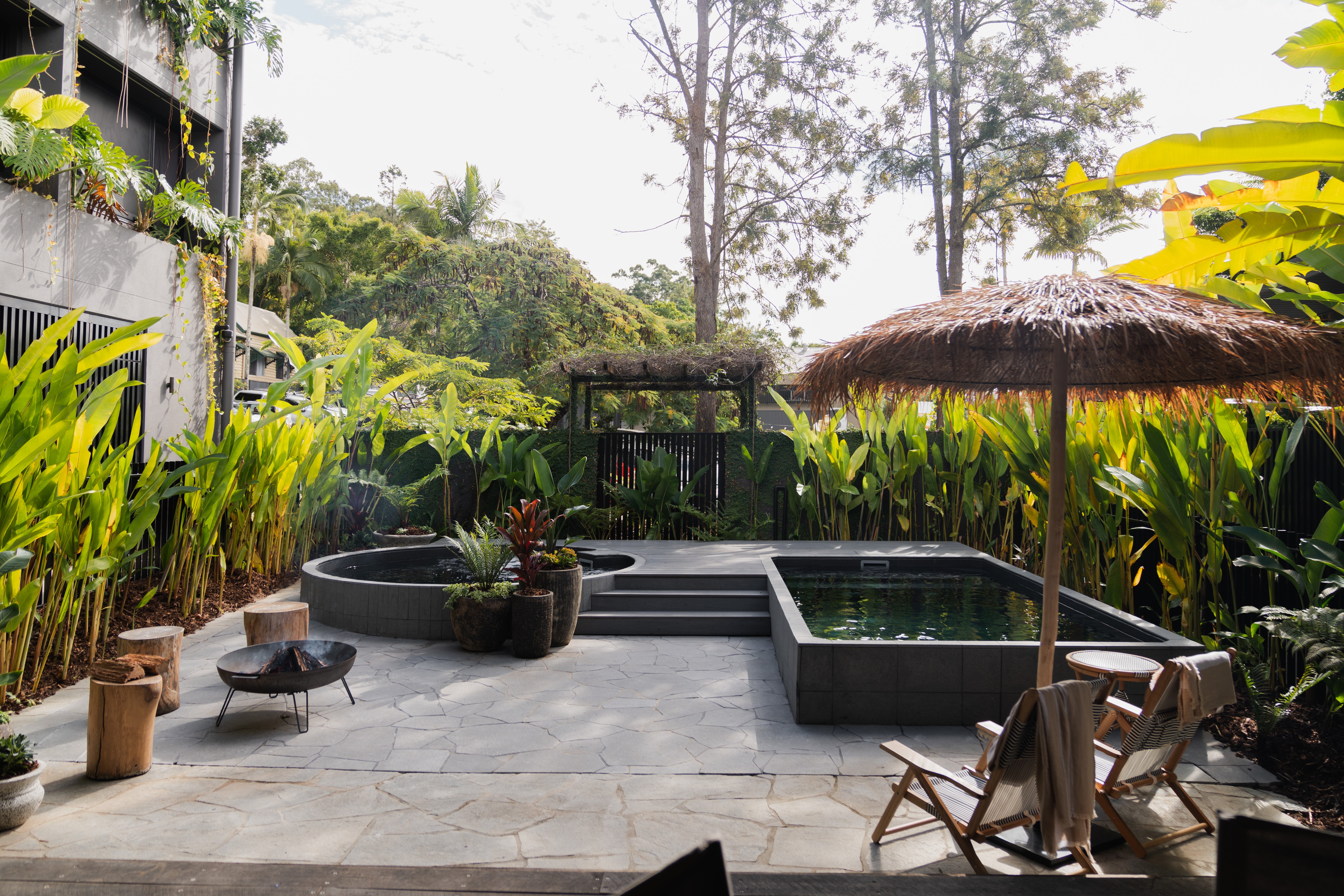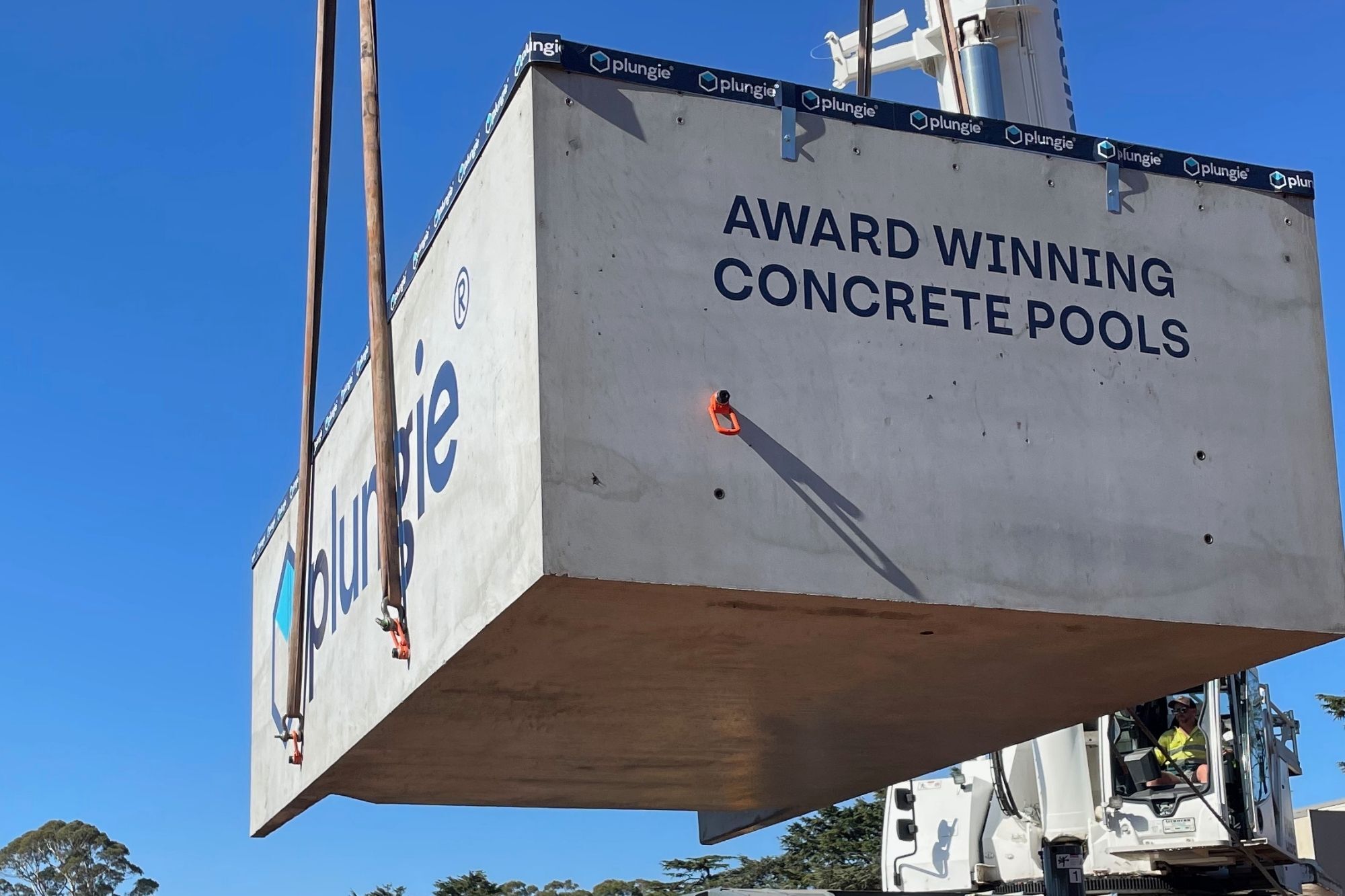Plungie has always been an innovator in the pool industry. From day one, we’ve used a patented, monolithic pour to create the strongest, watertight structures at the lightest possible weight. Our streamlined production process has also sped up concrete pool installation by up to 74%. Plungie CEO, Cameron Levick, credits off-site manufacturing for many of these efficiencies.
“We produce Plungies in a factory, and we get a lot of efficiencies because of this. We use less concrete in the pools because we have smaller walls and can design and engineer it accurately to reduce waste,’
Because concrete is an energy-intensive material, we believed that our manufacturing process would also give Plungie a competitive advantage when it comes to environmental impact.
We decided to put our pools to the test and undertake a comprehensive life cycle assessment (LCA) that would show exactly how our carbon footprint compares to competitors. This assessment was independently conducted and certified by Pangolin Associates, an Australian energy and carbon management consultancy. Pangolin is the leading provider under the Australian Government’s certified carbon neutrality program, with an experienced scientific team that holds the highest level of environmental accreditations.
The study compared our best-selling model (and the world’s largest monolithic precast pool), the Plungie Max, with an on-site-built alternative to see how they stacked up.
What Does The LCA Take Into Account?
The LCA is a cradle-to-grave analysis that evaluates the potential environmental impact of a Plungie Max manufactured and installed in Queensland, Australia. This includes the greenhouse gas (GHG) emissions produced during the whole life cycle of the pool, including raw materials, manufacturing, upstream and downstream transport, construction, and end-of-life recycling. Conducting such an extensive analysis was a must for Levick.
“The report goes beyond calculating the carbon footprint during the Plungie Max pool's construction phase to include corporate travel, the worker commute, and every detail until the pool's eventual removal and recycling 25 years down the line,”
Why Did We Undertake The LCA?
As leaders in the pool industry, we believe in continuous improvement. The LCA allowed us to assess our current GHG emissions and identify life cycle opportunities for improvement.
Although no Plungies have been in market long enough to be recycled, we wanted to explore end-of-life recycling and repurposing options as part of minimizing our overall environmental impact. This is something that sets us apart from pool manufacturers that use non-recyclable options like fiberglass.
“Fiberglass is one of those products that's not good for the environment at all. There's no way to recycle or repurpose it or turn it into anything else, so it ends up as landfill,” says Levick.
The Importance Of Carbon Footprint In Construction
With the buildings and construction sector responsible for approximately 37% of global GHG emissions, there is pressure on the construction industry to reduce the environmental impact of its products and services. As proud members of this industry, we want to be part of the solution rather than contributing to the wider problem. We don’t believe in burying our heads in the sand and ignoring market shifts.
By undertaking this analysis, we wanted to create transparency around our current environmental impact as that is becoming the industry standard. We chose Pangolin to undertake this work as they are carbon and energy management specialists — in fact, they were the first in their sector to be certified carbon neutral for their operations.
Get home improvement trends, project updates and industry news delivered straight to your inbox.
How Does Plungie Compare To A Traditional Concrete Pool?
So, how did the Plungie Max stack up against a traditional pool? The results showed that the Plungie produced 41% fewer GHG emissions than the on-site-built alternative pool. These results were so positive, they even surprised Levick.
“Depending on who you talk to, most thought that Plungie would achieve better results, but I don't think anybody thought it would be 41 percent better, even me,”
One of many contributing factors to this result is the use of an improved concrete mix from the global leader in concrete manufacturing. The assessment found that our improved concrete mix has a lower GHG emissions footprint than generic cement concrete.
In fact, using a traditional concrete mix would increase our GHG emissions by 5%. It’s clear that when you choose Plungie, you also benefit from the quality, innovation, and environmental initiatives of our global partners.
The study also revealed that the on-site built pool used 16600 lbs more concrete per pool (or 39% more by weight) and 720 lbs more steel reinforcement (or 42% more by weight). This goes to show that our patented monolithic design not only speeds up manufacturing and installation, but contributes to a much lower carbon footprint.

What Do These Results Mean For Professionals And Homeowners?
We understand that measuring the environmental performance of building work will only become more important for architects, builders, and developers. In the same way that we’ve streamlined the pool installation process, we’re streamlining the design phase by providing professionals with the information and resources they need.
“Architects are being asked to substantiate and map out the environmental impact of their projects, either for regulatory compliance, green building certifications or funding requirements. So, knowing the exact environmental footprint of our best-seller, Plungie Max, helps architects and developers,” says Levick.
This analysis is the latest in a suite of resources developed to make pool planning simple, including our BIM Content Library, Engineering Set, Plungie Specifications, and detailed Install Guide.
With Plungie, you can lead the way and offer an environmentally-conscious alternative to in-situ concrete pools to homeowners. This is just another way that our innovative pool solution can help build your reputation and differentiate yourself from competitors.
Contact our friendly team to learn more about the LCA today.




